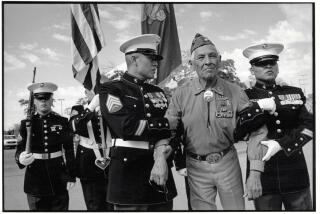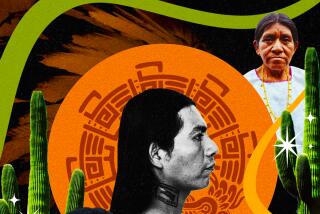Kenneth Hale, 67; Legendary Linguist
- Share via
Kenneth L. Hale, a linguist whose devotion to preserving native cultures and understanding the commonalities in human speech led to a legendary prowess with languages, including many that are now extinct, has died.
He was 67 and died of prostate cancer Oct. 8 at his home in Lexington, Mass., according to the Massachusetts Institute of Technology, where he taught for three decades.
Hale was a highly respected theoretician whose work on word order and structures contributed to a general theory of the innate human capacity for speech. He also championed the study and preservation of Native American and other endangered tongues by members of the affected cultures.
“He was . . . one of those very few people who truly merits the term ‘a voice for the voiceless,’ ” said MIT language theorist and social critic Noam Chomsky, who called Hale “one of the world’s leading scholars.”
A legendary polyglot, Hale could converse in more than 50 languages, including Navajo, Hopi and the Australian aboriginal tongue of Warlpiri.
“What was remarkable about him was this incredible ability to acquire languages. It was as if the linguistic faculty which normally shuts off in human beings at the age of 12 just never shut off in him,” said Samuel Jay Keyser, emeritus professor of linguistics at MIT and a colleague for 20 years.
At 12, Hale the linguist was barely getting started. He was 15 when he took it upon himself to tackle several Native American languages. Later in life, he spoke Irish so well that a visa officer at the Irish embassy in New York asked if he knew any English. On another occasion, he astonished a colleague who asked Hale what strange language was being spoken by some students in the cafe they were visiting; Hale not only knew it was Basque but began speaking it.
His facility with far more obscure tongues sometimes led to an unwelcome solitude. He knew so many languages that were extinct or on the brink of disappearing that he once told a colleague, “I have no one to speak them with!”
One of his last projects was helping the Wopanaak Nation, a Native American group in southeastern Massachusetts, revive its Wampanoag language, which had not been spoken in seven generations. It is now used by many of the 3,000 remaining Wopanaaks clustered on Cape Cod and Martha’s Vineyard.
Hale moved at age 6 from Chicago to a ranch in Canelo, Ariz., where he rode on horseback every day to a one-room school.
When he was 15, he enrolled in Verde Valley School, a multicultural, college-preparatory school in Sedona. Assigned a Hopi roommate, he decided to learn some Hopi. Rooming next with a boy who spoke Jemez, another Native American language, he not only learned some Jemez but devised a written form of it.
Soon he knew that he “didn’t want to spend time on anything other than languages,” said his wife, Sara, who attended Verde Valley School with him. He persuaded his parents to let him transfer to Tucson High School, where he hoped that “benign neglect” would allow him to concentrate on his passion. He explored O’odham, Cherokee, Navajo and other Native American tongues. He made up a Polish name for himself so he could join the campus Polish club and learn that language. He pumped locals for the vernacular form of Spanish spoken around Tucson.
He did indulge one other passion: He rode bulls. One of his proudest possessions was a trophy belt buckle he won at a rodeo sponsored by the University of Arizona, where he earned a bachelor’s degree in anthropology in 1955.
He went on to Indiana University at Bloomington for his master’s and doctorate in linguistics. After earning his PhD in 1958, he spent three years surveying Australian aboriginal languages on a National Science Foundation grant.
He taught at the University of Illinois-Urbana and the University of Arizona before joining the MIT faculty in 1967.
Andrew Carnie, an assistant professor of linguistics at the University of Arizona, recalled how astonished he was by his former teacher’s linguistic agility. During class demonstrations, Hale would sit with a speaker of an unfamiliar language “and within 10 minutes he was able to start conversing--not very fluently and not about anything profound. But he was able to absorb the structure of the language right away,” Carnie said.
Hale once said that every language represented “intellectual wealth,” and he traveled to the ends of the world to find it.
During his swing through Australia in 1959 and 1960, he discovered an aboriginal group that used two languages, Lardil and Damin. The latter was a highly sophisticated and abstract version of the first and was used only by young men undergoing a ritual initiation. It was evidence, he believed, that language did not evolve by accident but was “the product of human intellectual toil.”
When the last seven speakers of Lardil and Damin died, he mourned the loss of an entire culture.
“When you lose a language,” he told an interviewer, “it’s like dropping a bomb on a museum.”
His focus in his last years was on reviving extinct languages, in particular Wampanoag.
“A lot of linguists feel it is not really possible for tribes to reclaim an unspoken language. Luckily, Ken was not one of those people,” said Jessie Little Doe Fermino, co-chair of the Wopanaak Language Reclamation Project in Mashpee, Mass. Wopanaak tribes were the first to greet the Pilgrims in 1620.
“What was incredible about Ken was he didn’t consider languages to be dying,” Fermino said. “The term ‘dead language’--you would never hear him say ‘dead.’ He believed that language is created with the person.”
At his urging, Fermino, a former social worker, earned a master’s degree in linguistics at MIT so that she could help lead the effort to revive Wampanoag. Hale also recruited to the institute a Navajo and a Hopi who are believed to be the first Native Americans to earn doctorates in linguistics.
Fermino believed that Hale was “predestined” to guide the Wampanoag revival effort. He was a direct descendant of Roger Williams, a 17th-century missionary who helped translate religious materials into Wampanoag.
When Hale’s friends and family gather at MIT next month for a tribute, the memorial remarks will be delivered in Hopi, Navajo, Warlpiri and Wampanoag.
In addition to his wife, his survivors include sons Whitaker, Ian, Caleb and Ezra; and a brother, Stephen. Memorial donations may be sent to the Navajo Language Academy, c/o Peggy Speas, Department of Linguistics, University of Massachusetts at Amherst, Amherst, MA 01003.
More to Read
Sign up for Essential California
The most important California stories and recommendations in your inbox every morning.
You may occasionally receive promotional content from the Los Angeles Times.














